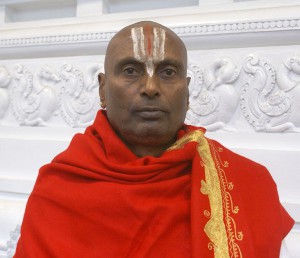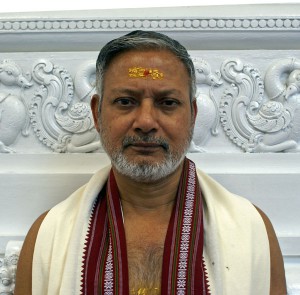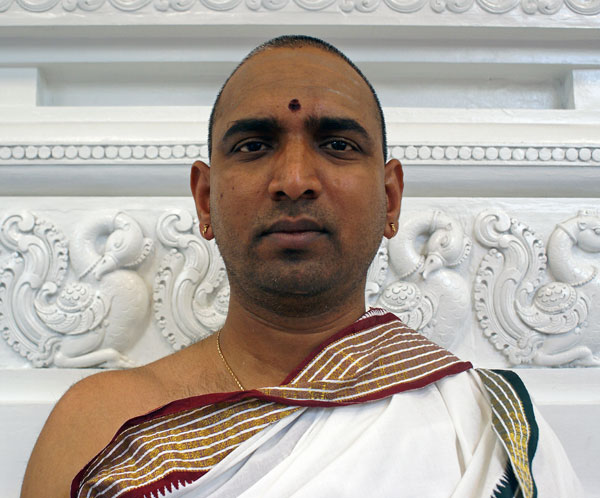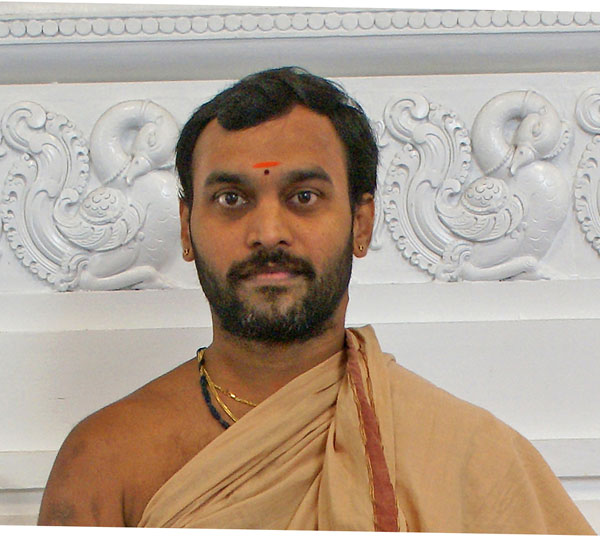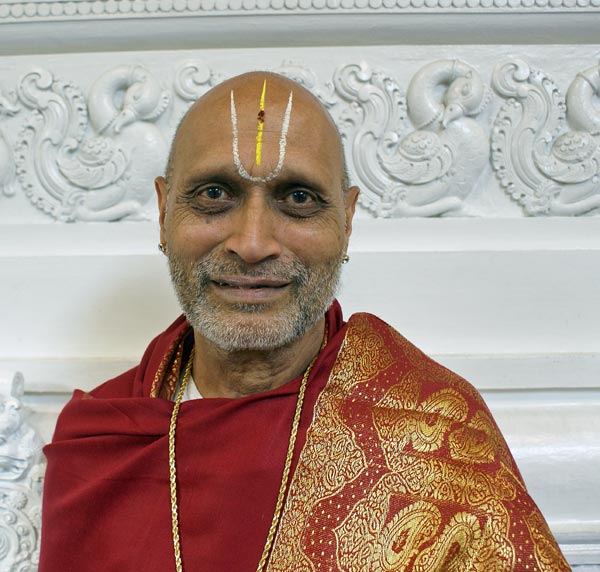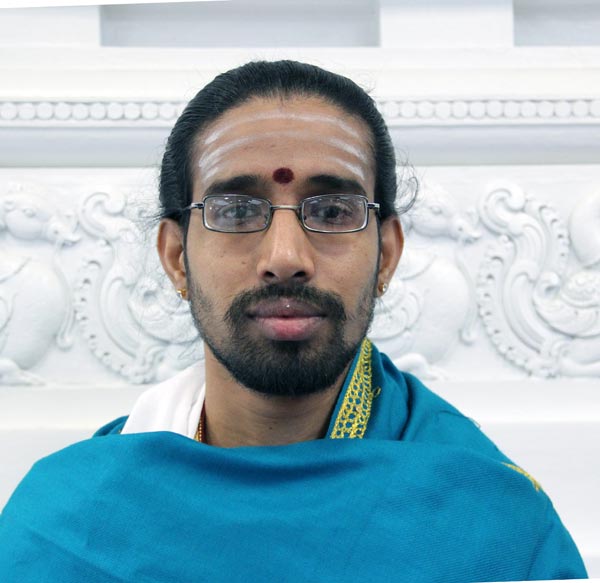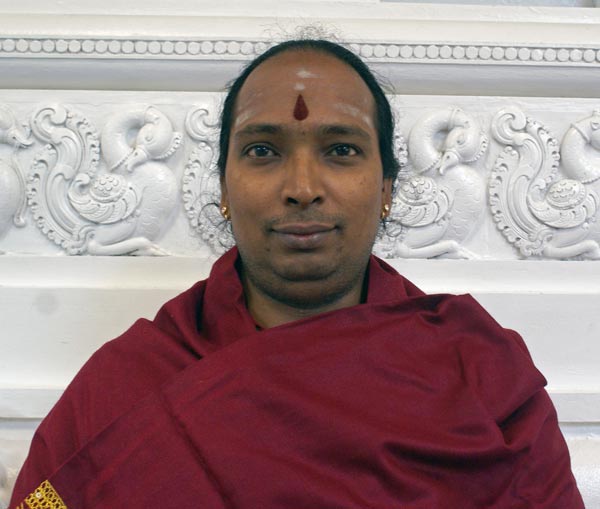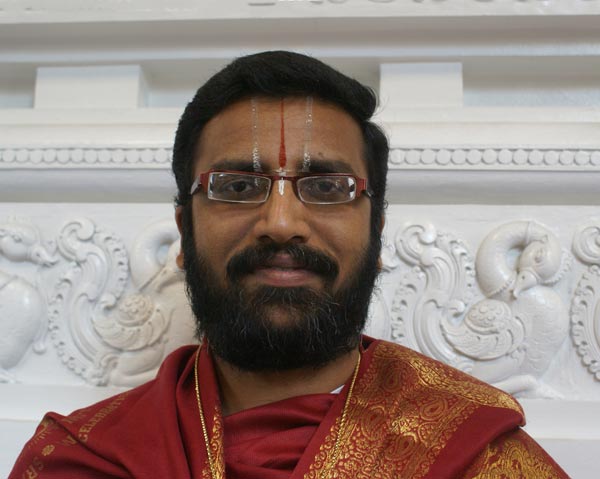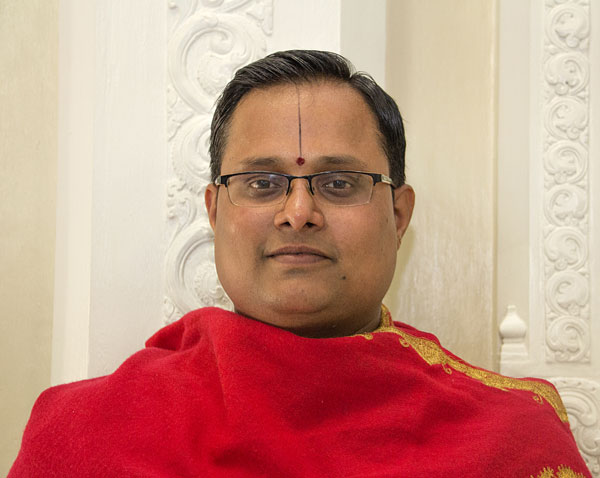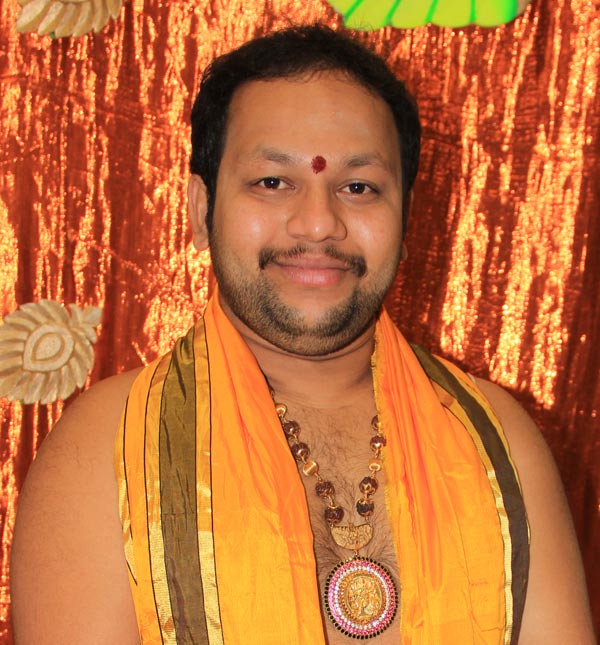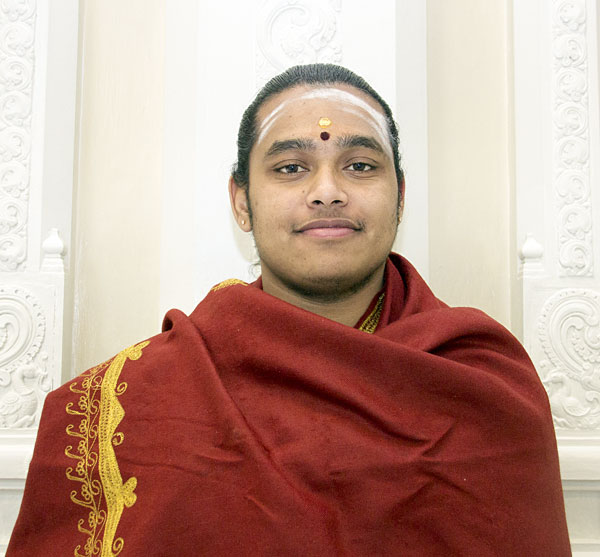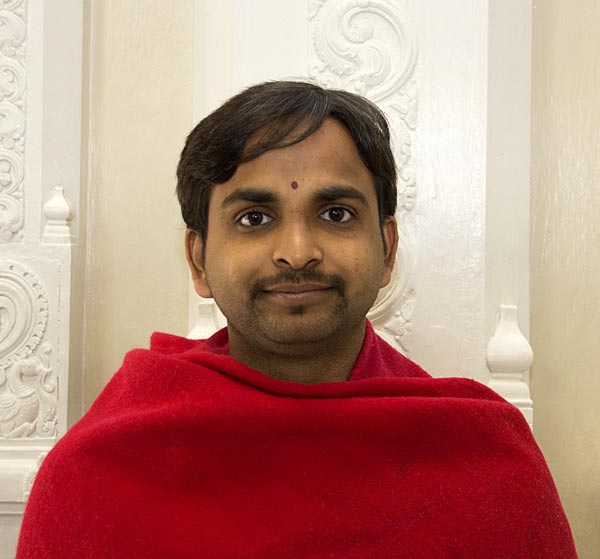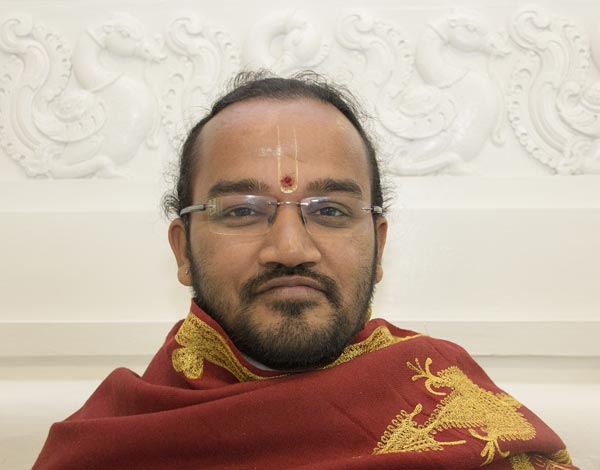Temple Architecture
Temple Architecture: The Living Tradition
V. Ganapathi Stapathi
Our people have revered and nurtured from time immemorial five forms of graphic art: music, dancing, sculpture, and architecture- – as basic art forms. These arts not only give us immense pleasure and aesthetic fulfillment, they also serve as the means of uplifting our spiritual well being. – Western researchers have now begun to appreciate with wonderment the subtlety with which our architectural tradition has endowed our land, cities, homes and hearths, temples and ponds with a spiritual content. Sculpture has combined with architecture to inspire music. This inter-connected sense of underlying unity is a matter for reverence and awe.
People in other lands have developed their own basic forms of art similar to the five forms that are characteristic of India. The inner sense of satisfaction, aesthetic pleasure and spiritual well-being that our traditional art forms generate stand tall as the Himalayas and compares with the aesthetic satisfaction provided by the art forms in other lands. This is no mere parochial hyperbole but a statement of truth. -What is the basis of this claim? It is a question worthy of deep research. It is hoped that research scholars will probe deep into these questions and provide us enlightenment.
I strongly believe that the basic cause for the wide appeal of music, dance, sculpture, and architecture is their grammar: this is because art forms have their own grammar in much the same way that a language is served by a grammar and in both cases that grammar is characteristic of our land.
Poetry or the coinage of a text is one form of expression of one’s inner impulses and inspired thoughts. In this case, feeling is conveyed in the form of sound, which we appreciate and enjoy through the faculty of hearing. Similarly an image in dimensional perspective is presented through lines, points, and shapes; these elements are the basic blocks of an art form, which is appreciated and enjoyed through the faculty of vision. Indeed both these forms of appreciation and enjoyment reside in the heart and mind of the observer and nowhere else.
We employ a unit of measure for linking words to express an idea or concept. This is a unit of time, and we may call it a system of measurement of time. It would not be out of place to say that we present word pictures through a framework of units of time. In daily life we use measured speech to express our thoughts, and we employ similar units in drawing pictures. Without a system of measurement speech or writing will become meaningless. It is the system of measurement and an orderly use of the units of measurement that constitutes that grammar of a language.
In like manner, we recognize that music and graphic arts are also based on units of time measurement. This time measurement is known in artistic language as the basic rhythm (Thalam) cycle. In our musical parlance, this rhythm is called “Thalam” because the rhythmic beat is kept up through demonstrative clapping.
Thus while units of time form the foundation for integrating musical sounds, it is not as easily appreciated that these time units are converted into units of space and position in sculpture of idols or icons, construction of buildings, and layouts of cities and towns in time-honored traditions of our land. Our sculpture reflects time by conversion of time units into linear and space measures in “VAASTU” art which has flourished for over 3000 years.
This VAASTU art enables an invisible measure (time) to be brought within the perception of human eyes. This concept is not generally accepted or understood. Setting aside the popular perceptions of modern scientific approach, the present day Silpis (artist craftsmen in temple architecture) pursue this “VAASTU” approach. Considerable interest has been aroused among current researchers in the study of this approach.
Not only is this use of a time measure (thalam) unique but there is a further subtlety to be brought to the notice of learned people everywhere- what is time? If units of time can be translated into units of expression of a thought or concept, what is “position” or “space”? Are the both the same? These questions are in a modem context. They were raised and answered in our land long eons back and used in the evolution and practices of daily experience. But they lie hidden. Truly they represent an intellectual achievement of high order. To which period of history could we ascribe such evolutionary answers? Can researchers provide a clue? Has anyone noticed such discussions in our sastras or literature or in scientific books of other lands? Let us take a look at the volumes of grammar that we have. Whether they relate to sculpture, or architecture, or music, the literature deals with the technology of art form rather describe its science. Although we tend to regard Sastras as laying the foundations of the science of an art form, modern scientists have yet to accept this view, which underlies physical sciences. The artist created form is governed by a spiritual grammar. However the technologies of this art form are expressed with such depth and sweep, and so many visual and aural art forms have blossomed forth that it is necessary to look for an underlying scientific basis. Where is this to be found? That remains the prime question confronting researchers today. Great scientists like Einstein and Archimedes might have sensed this link. Modem scientists should have the experience of the artist’s sense of spirituality.
It is best to answer this question first by recalling visual experience of the artistic excellence and expression that they have achieved, recognizing the faith that they inspire, and then stating what we believe to the basic science or casual spirit underlying this achievement. People in the Washington area have before them some excellent examples of authentic temple architecture that have been created using locally available material but reflecting the same inspired motivation and skills that we see reflected in the gopuras and the granite halls of temples which stand as mighty monuments all over South India from Andhra down to Kerala. The link between the technologies of these art forms the casual science that brings forth the true nature of these artistic achievements is inspiration. Man’s inner self pulsates with energy and his feelings for outer space gets translated into art forms. The inner self is in communion with space in this experience. The manifestation of this form defines the outline of space. But feeling determines the outline and is fueled by the pulsations of the inner self. These pulsations get transformed into the harmonious gyrations of the strings of the veena creating music; spatial art is a similar product. Vocal speech or written text gets transformed into granite images and icons. Energized by the pulsations of the divinity in man, the image or concept takes on a spatial form. The pulsations are in this case units of time measure.
There is harmony within our inner self and the environment around us. Environment provides the constituents of matter in the external world and the consciousness of the objects in the external world is reflected in our understanding of nature. Shapes in external space are objects of dimension. The common element of these different forms is in the system of measurement of time No concept can be explained or understood without the system of measurement. The truly inspired artist channelizes his aesthetic sense with discipline and taste and calls of rhythm in music and dance, in poetry and indeed in sculpture. Even architecture adopts this system of time measurement. In music as well as in sculpture the artist is conscious of the basic form, which his creation will take, and he operates within a set rules of grammar (e.g. talapramana for the musician), but the artist creates the product through a combination of skills and virtuosity of style and inspiration. The inspiration, which symbolizes the harmony between his dedication and the environment, enables the musician display his sense of lyricism and makes the sculptor clearly visualize the subtle form in his inner self and exhibit it in the gross form that he creates. All great objects of temple architecture are true reflections of the spirit of man in quest of understanding divinity in its many manifestations.
The VAASTHU tradition therefore provides the discipline which enriches the philosophical knowledge, and secular skills leant from a teacher and makes the student of temple architecture receptive to the inspiration which acts through his personality and dedication (bhakti). This tradition results in the creation of mighty monuments to man’s quest for an understanding of nature in all its diversity and the unifying divinity in it. Devotee worship and faith do the rest: they make the temple a living organism.
Outlines of Temple Architecture
The temples in India have played a versatile role in the life of its people and have been the dominant and inseparable part of their cultural and spiritual activities from the early times. People, from the crown to the common, from the saint to the scholar have frequented temples and held them as sacred objects of worship and sources of solace and bliss. In fact, the cream of Indian culture is enshrined in the temples. The cultural life of the Indian race is built around the temple. This culture is spreading fast today, all over the world. This system of temple culture has not been replaced by any other system up to this day. It is so strong, effective and efficacious that no alternative became possible. It is based on truth, not on mere faith.
Modern scientific analysis of a temple goes to establish that temple-space is surcharged with enormous positive energy and the visitors, frequenting the premises attain physical welfare and mental well-being. How could a mere structure built of stone or of brick and mortar contain that kind of energy? What makes the temple structure and the premises so powerful? What do the temple components like Garbhagruha, Mukhamandapa, Vimaana, Gopura, Praakaara, Minor shrines, Pillars and various other parts of the temple structure mean? Do they have any scientific basis or are they mere imaginative, artistic edifices to house sacred forms and symbols of religious concepts?
Also it is a scientific truth that a temple is not a home of God but it is the form of God. In other words, the temple structure itself is worthy of worship and in that context; the God form installed inside is redundant or superfluous. There is truth in it, hence I am emboldened to say so. Temple building is not a congregational structure but a form of God structurally delineated.
This aspect of the temple as a form of God is implied in the Upanishadaic statement of ‘Prasadam purusham matva poojayet mantra vittamaha’. The literal meaning is that the priest well versed in mantras shall look upon the temple building (prasada) as Purusha (embodied energy called Vaastu Purusha) and worship him with due respect. The meaning further noticeable in this context is that a temple building is a composite of the Sukshma (subtle) and Sthula (gross) aspects of the Supreme Being. The Sukshma is the subtle space enclosed in the sanctum and Sthula is the material form built around it. Also the temple structure is realized as the body and the inner space enclosed as the spirit. And the circumambulatory space around the temple sanctum called praakaraas is the rhythm bound spatial expansion of the inner space. In other words, the temple layout is the extended form of the ‘rhythm’ of the inner space (the Daharakasa). Therefore in the Vaastu tradition, the temple complex is designed according to what is called musical layam, where layam means rhythm (or swara vinyasa). Hence architecture is defined as frozen music as well.
In the traditional Vaastu Shastras, the concept of temple structure as the extended material form of the jeeva is vividly described in a technological language to aid designing of temple forms meaningfully. The temple form is designed into Viswaroopa (visible material universe). Is not the human body, an extended form of the inner being, and the subtle into gross? The Vaastu sloka goes on thus:
SLOKA/PRAYER
Upapeetam charanakara, adhistanam janu mandalam,
Pada vargam karakaram prastaram bahu moolakam,
Tatkantam gala mithyuktam shikharam mukha mevache,
Ushneeshantam shikha chaiva mahanasicha nasika,
Netranam kshudra nasyau cha viswarupa mithi smirutam.
There are a certain number of parts, with which the limbs of the temple structure are composed, just like the human form being composed of limbs such as foot, leg, thigh, torso, hand, neck, head and the hair lock. The components of the temple form, as expressed in physical terms, may be noticed in the accompanying diagram. The human scale (taala unit/kaala maatra) is simultaneously shown side by side. The subtle is in 8 units and the gross is in 9 units. The structure is the concept of Mayonic science wherein human laya (order) is brought into application.
There is a profound scientific concept underlying the creation of Vaastu structures whether it is a temple building or a house building. At present let us focus our attention on the temple structure. To understand the composition of the structural parts of a temple, one should know the scientific concept in its layout and its significance. It is the scientific layout that determines worthiness of the form. The layout adopted for temple form is synonymous with the layout of the Cosmos! This is the basic concept, which confers pan-Indianness of the temple design and lends national character to the temple-culture.
The plan of the layout of a temple is technically called Mandala or Vaastu Pada with a grid of 8 × 8 = 64 spaces or 9 × 9 = 81 spaces of equal dimensions. In modern architectural terminology this can be addressed as energy-grid. These layouts are squares, two dimensionally and cubes, tri-dimensionally. Those two layouts are the geometrical formulae for the shilpi to replicate the subtle substance of the universe into visual material form. This is the formula handled by Jagatguru Viswakarma, the creator of the universe, to turn his own thoughts into material forms. This formula is couched in a simplistic saying vastu reva vaastu meaning “it is the subtle that turns into gross”. Here Vaastu is subtle energy and Vaastu is embodied energy. This was discovered and put into the Vaastu texts by Mayan, the author of Mayamata, Vaastu Shastra and of Surya Siddhanta, the most ancient treatise on Astronomy. The application of this principle confers sanctity on the man-made structure of a temple and makes it worship worthy. This is the scientific truth of the highest order underlying temple design and temple culture.
To understand this concept still more clearly, one has to go to the very root of the genesis and evolution of the universe. The root exists in the vast luminous space (akasa) that surrounds the earth and for that matter every object of the universe. The space under reference is not a space of nothingness but a space filled with energy or spiritual light. As a matter of fact, the space is mathematically confirmed to have been packed with countless cubes of energy of Paramanu size. One such cubical space dwells in the cave of our heart and in the hearts of all animate objects of the universe. This cube with a square base is called Vaastu Purusha Mandala where ‘mandala’ is square and ‘purusha’ is energy. ‘Vaastu purushah chaturasra samsthaha’-“the all pervasive energy is couched in a square” – so says Vaastu Vidya, a treatise on architecture. Vaastu Purusha mandala represents, infact, the micro universe and quality wise and shape wise the micro and the macro are one and the same. That the space is the primary source of all animate beings is justified further in the upanishadaic saying, ‘akasat vayuhu vayoragnihi agnerapaha adbhi prithvi prithivee bhyam oshadhayaha’. The meaning is that the air, fire, water and earth have come forth in successive developments from the SPACE. The vegetation further came out of the Earth, which acted as another space (source) called earthly space. The shorter version of this phenomenon is that the Earth came out of the Space or the Space is the source of the Earth. In fact, it is from one single paramanu that the Earth has come into being and hence the energy contained in an ‘anu-sized subtle energy’ and the energy contained in the Earth itself have come to be called by a common term Vaastu Purusha and hence the container and the content have together come to be called Vaastu Purusha Mandala. The layout of the spherical earth is identified to be Vaastu Purusha Mandala of 9 × 9 = 81 spaces whereas at subtle level, it was of 8 × 8 = 64 spaces of energy grid. Hence the mandala of 8 × 8 and that of 9 × 9 are said to be ‘subtle’ and ‘gross’ respectively. Area wise, the square and circle are equal, in spite of its growth from anu to anda (in terms of proportions). This theory is applied in all animate beings from insect to elephant. The square Vaastu Purusha Mandala is the wave pattern of primordial energy and infact it is the primal manifest form of the non-manifest, which grows into material form ultimately. All visual and audible forms come under this theory. The resultant mathematical formula is that o = ¡, meaning that the subtle is qualitatively and quantitatively equal to gross. Mayan also says, ‘Prasadadini vastuni vastuvad vastu samsrayat tanyeva vastu reveti kathitam vai vastu vid budhaihi”. The meaning in simple words is that buildings, be it a temple or a house, are all embodied energies, signifying the co-existence of energy and matter (Vastu and Vaastu). Is this not the unified theory of energy and matter?
So Vaastu Purusha Mandala, the plan of the primordial cube of energy is utilized as the plan of the temple, as per the directive of Vaastu shastra. How sacred and scientific is the principle governing temple form? Is this not secular and universal? The three dimensional cube is the basic structure of the sanctum into which is placed the idol for worship. Around the cube a variety of bands and motifs are added on to give a pleasing alluring look and to conform it to human form in structural terms. This cube is traditionally denoted by the epithets Chitravain Chitrambalam and Chidambaram which means ‘mini hall’. This I have named as ‘Micro-abode’ and ‘Microbode’. So every temple structure, as per Vaastu tradition, is a microbode, within which the free space is enclosed. What does this microbode, the mini hall contain? It is a spark of cosmic fire that lies centered. This is called Brahma bindu. This is again OM light, the vibration of which causes the Om sound. The vibration of this Om light is called Time or Kaalam. The vibration of the primal OM light is the dance of Lord Siva and that of sound is Uma. Hence ‘Omkara’ Natana. Uma is ‘word’ (vaak) and Siva is ‘meaning’ (artha). So Mayan says that Kaalam is the creative element of all the objects of the universe and adds that the universe itself is the product of Time. “Time is the creative source of all objects. It is time that changes into form. It is time that blossoms into the universe and Kaalam thus does wonders”-Mayan. Therefore Kaalam itself is designated as Kaala Brahman. Kaalam, in simple words is the speed or vibration of energy or light. The summum-bonum of these discussions is that vibration causes all phenomena. This concept is extended to poetry, music and dance where Kaalam is redesignated as Taalam, maatra or kaalam, the ruling element of all forms of poetry, music and also dance. What would be unique and astonishing is that the same Taala measure is extended to create visual material forms (time-spaces) of which one is the building whether it is a temple or house. Sculptural representations are also born of this scientific theory of rhythm (Taala) and therefore they are divine and worship worthy.
The concept of Vaastu, in this context, is that it is the minute cell of energy (microbode) which changes itself into material body (Vaastu) by virtue of the vibrations emanating from the energy. In other words, all living organisms have sprung into material existence out of the seed and speed of divine energy. Hence the sanctum is held to be a living organism capable of ‘vibrating from within and spreading into a space of energetic particles’. These vibrations have been quantified just as we have quantified the sound vibrations emanating from a stringed instrument of music. These measures of sound vibrations have been assessed to be equal to material vibrations and thus got extended to create material spaces called buildings.
Another important concept of Vaastu is that this small cell of energy is called ‘foetus of space or ‘garbha by which the structure has come to be called Garbhagriha and Karuvarai . Also called Bindu Griha in Agamas. ‘Karu’ is the energetic space-atom and the structure enclosing it is ‘Arai’. Our Garbhagriha structure is so designed in terms of frequency of vibrations called ‘rhythm’ that the energy-waves emanating there from, are productive of positive effects on human psyche, in as much as musical vibrations are controlled by numerical adjustments to produce sweet sonic effect in human mind. Because of such structural vitality one feels edified when one steps into the temple ambience or stands in front of the sanctum. This will happen irrespective of the structure enshrining an idol or not. Such is the spiritual significance of the very structure of Garbhagriha.
The temple architecture is a scientific phenomenon. Let me complete by saying that the music is enjoyable because of the science underlying musical composition and rendering the song. These are musical forms heard and enjoyed at heart. Similarly, the same science underlying the musical forms are visually seen and experienced at heart in a temple premises. The effect is one and the same.
About the Author:
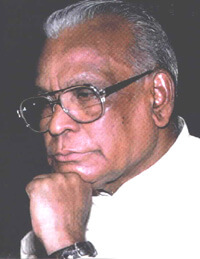
Sri V Ganapathi Stapathi comes from an unbroken lineage of renowned Stapathis. He has devoted a large part of his life to reviving the art and science of Vaasthu shastras. He has trained many people in the traditional methods of sculpture and architecture while serving as the Principal of the College of architecture and sculpture at Marnallapuram. He has also initiated, trained and developed a few talented individuals through the traditional Guru Shishya modality. Sri Ganapathi Stapathi has been designing traditional temples in lndia and abroad for more than three decades He has won many awards from the Stare and Central Governments for the services he has rendered to the tradition.


